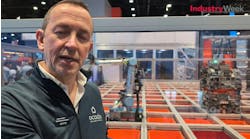Given the uncertain economic future facing the United States and the rest of the world, it shouldn’t be surprising that a survey of company executives conducted recently by Honeywell Intelligrated found that while many may wish to be on the leading edge when it comes to warehouse automation, they also want to avoid being on the bleeding edge.
Overall, businesses have a positive outlook on growth and will be relying on warehouse automation processes to maintain that optimism, according to a survey conducted by the company this spring with the help of KRC Research. The survey also found that the same executives are aware of the need to cultivate skilled employment in the warehouse workplace to manage and maintain these investments.
The poll revealed improving automation processes is the most common top-ranked goal for supply chain managers in the next one to two years. When given a list of possible goals, 14% of companies rank improving automation within their facilities as their top priority, and 37% of companies rank it in their top three goals for the near term.
In spite of their recognition of the importance of improving automation processes, only 43% of companies that list automation as one of their top strategic goals also say they are very prepared to achieve it, the study found.
“Distribution and fulfillment operations often struggle with how to plan and execute the transitions to automation. The COVID pandemic has accelerated conversations around defining the right technology and solution strategy and deployment plans for their respective business,” says Christine Feuell, chief marketing officer of Honeywell Intelligrated.
“For example, the e-commerce industry has experienced rapid global growth from users of all generations due to stay-at-home mandates and social distancing requirements. More consumers are adapting their shopping behaviors as they see the convenience it provides. These shifts in how consumers buy and take delivery of their orders influence the type of automation and fulfillment strategies companies will require to help achieve the customer service levels that customers expect.”
Honeywell Intelligrated notes that the National Retail Foundation and other observers have been able to quantify the enormous increase in shopping online as a result of COVID-19, and those numbers are expected to grow as the pandemic lingers, diminishing and surging in stages over the coming months.
For the supply chain executives who have piloted an automation solution, they have found the results to be overwhelmingly positive, the study discovered. More than 85% say the solution has led to positive business outcomes for their companies, and half say those positive outcomes are significant.
Cost of implementation is the main reason for hesitance of investment in automation, with nearly half of companies polled mentioning it as a major barrier to automation adoption. In this regard, the consumer packaged goods (CPG) industry is the leading industry sector, with 55% of respondents in the group saying cost of implementation is the biggest barrier to adoption.
One third of those surveyed mentioned the difficulty or complexity of implementation as a barrier to automation adoption. As an example, nine in 10 companies said they see positive outcomes using automated storage and retrieval solutions (AS/RS) technology, a widely used automation solution across industries. On the other hand, eight in 10 also said that implementation remained a challenge.
As fast delivery continues to become table stakes in various industries, companies are creating micro-fulfillment centers in or near city centers to be able to maintain high levels of customer service. This includes conversion of big-box retail stores and some shopping centers into distribution facilities.
The Human Factor
While this automation technology has been proven to maximize efficiency and productivity in multiple industries, there is a major investment in time and training required as well, Honeywell Intelligrated points out. The process of installation, labor training and integration into other software systems can take anywhere from 12 to 24 months.
“Companies need to understand that installing new automation technologies is not plug-and-play, and these solutions need to be integrated into their software and control systems to ensure they enhance operational performance,” Feuell observes.
Of those whose companies have chosen to invest in automation, the executives report that most important limitations have arisen from high cost of maintenance (55%), frequency of maintenance (42%), lack of flexibility or adaptability (35%), difficult user experience (29%), lack of interoperability (29%), and “clunky” robotic components (27%).
For example, AS/RS shuttle technology helps move higher volumes of product and makes the best use of valuable storage space. Although nine in 10 of the executives say they are seeing positive outcomes, eight in 10 say implementation is (or was) a challenge.
As automation in supply chains progresses, it can lead to opportunities for new jobs within different workplaces. Two in three companies see opportunities for new and different jobs in customer service, distribution centers and warehouses, according to most of the executives surveyed.
In September, the Bureau of Labor Statistics reported that warehouse employment had exceeded its pre-pandemic level, hitting the largest number of workers in the industry recorded in history, with 1.25 million workers employed in the warehouse and storage sector. This also was credited to the boom in e-commerce sales during the pandemic.
Most of these new warehouse jobs will require skills that are more advanced than those for the jobs that automation will be replacing. “These automation and robotics advancements are shifting the workforce away from physically demanding, strenuous and monotonous tasks to more skilled tasks,” Feuell notes.
The study reveals that eight in 10 companies see the highest potential for new jobs arising in in-house maintenance roles. (Remember that 42% of respondents also mentioned the costs and frequency of maintenance as the most important limitations of automation technology in use at their companies today).
As infrastructures within warehouses and fulfillment centers become more automated, Feuell points out that maintenance technicians will play a crucial role in helping limit downtime. “Even though machines are getting smarter, humans are still needed to program, build and repair them. Human intelligence is still essential to identify problems and mobilize computers and people in tandem to get the job done.”




